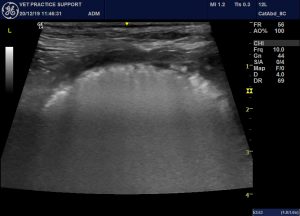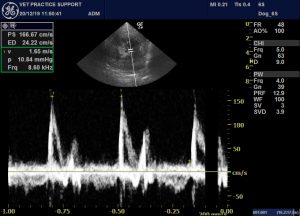Asymmetric or unilateral cardiogenic pulmonary oedema in dogs
There’s a nice JSAP paper by Livia Benigni from a few years back which revealed the variability in distribution of pulmonary oedema in the lungs of cats with congestive heart failure.
J Small Anim Pract. 2009 Jan;50(1):9-14. doi: 10.1111/j.1748-5827.2008.00655.x. Epub 2008 Aug 13.
Radiographic appearance of cardiogenic pulmonary oedema in 23 cats.
Benigni L1, Morgan N, Lamb CR.
https://www.ncbi.nlm.nih.gov/pubmed/19037891
I think this was a somewhat unexpected finding at the time. In human medicine, local or unilateral cardiogenic pulmonary oedema (CPO) is well documented but rare.
Handagala, R., Ralapanawa, U., & Jayalath, T. (2018). Unilateral pulmonary edema: a case report and review of the literature. Journal of medical case reports, 12(1), 219
https://www.ncbi.nlm.nih.gov/pmc/articles/PMC6090641/
Below are some lung ultrasound images of a Bichon Frise with mitral valve disease presenting with acute onset tachypnoea/hyperpnoea. The patient is standing and unsedated.
First the left side:
And then the right:
And the oedematous side as a frozen image:

Lung ultrasound: left hemithorax demonstrating coalescing B lines typical of interstitial syndrome (oedema)

Transmitral PW Doppler shows very rapid early LV filling
This can be a challenging presentation because marked asymmetry of lung interstitial syndrome raises the possibility of oedema due to trauma, lobe torsion or pneumonia.
In this case the patient responded promptly and completely (over 24 hours) to frusemide therapy.
Although a few mechanisms have been suggested for this phenomenon, the fact that in human medicine it is relatively specific to patients with severe mitral valve insufficiency (rather than to patients with left sided congestive failure generally) strongly supports the hypothesis that it is the selective impact of high velocity eccentric mitral regurgitation jets on the pressure in certain pulmonary veins which leads to localised CPO.





